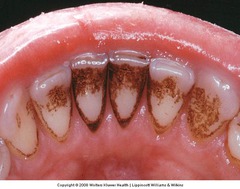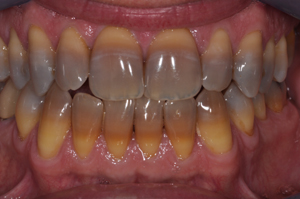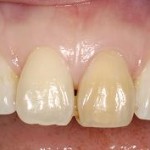Teeth can have extrinsic staining or intrinsic staining.
- Extrinsic stains result from the adherence of colored material or bacteria to the enamel of teeth.
- Intrinsic staining is a change in the color of the tooth structure, enamel or dentine, due to a genetic or acquired abnormality.
Extrinsic staining
If you want to know what causes tooth discoloration, extrinsic stains are very common and fortunately often easy to treat. Most extrinsic stains tend to be in the gingival third of the tooth, that is the area close to the gum where bacteria often accumulate an absorb stain. I cannot discuss every possible cause for staining but these are the most common reasons:
- Tobacco, mostly smoking, usually causes brown or black stains.
- Calculus often adheres to the external tooth surface and appears tan/yellow or even greenish-black. Calculus or tatar is a form of hardened dental plaque. It is caused by precipitation of minerals from saliva and gingival crevicular fluid (GCF) in plaque on the teeth.
- Cromogenic bacteria produce brown or even green stains, resulting from the interaction of bacteria with iron and ferric sulfide in the saliva and gingival crevicular fluid (fluid coming from the gum).
- Tea, coffee, wine, cola drinks and some sports drinks, especially if consumed in excess.
- Foods, often vegetables rich in xanthonoids and carotenoids. Carotenoids are organic pigments that are found in plants and some other photosynthetic organisms, including some bacteria and fungi. Xanthonoids is chemical natural phenolic compounds.
- Chlorhexidine is an antiseptic commonly used in mouthwashes and toothpastes. This is an excellent product, often prescribed for the treatment of gingivitis (gum disease), but usually it is best to limit the use of Chlorhexidine gluconate 0.2% mouthwash to a month. It destroys the bacteria in the plaque. If the plaque is not removed, other staining agents will discolor it.
- Amalgam restorations can leak into dentin and produce blue-gray stains.
Caries can also appear to be stains, but they cause loss of tooth structure. If you are not sure if it is tooth decay (caries) or just staining, I suggest that you get your teeth checked by a dentist.
Tooth colored fillings can also discolor. Often this can be rectified by your dentist in seconds as the restorations may just need a quick polish. Occasionally the restorations may require replacement.
Treatment for extrinsic staining
In general, the best treatment for extrinsic staining is regular visits to your dentist or oral hygienist for ultrasonic scaling and also polishing of your teeth using relatively abrasive polishing paste. Even more importantly is keeping immaculate oral hygiene by thoroughly cleaning your teeth at home on a daily basis. Remove the plaque and food before staining can occur. Consider investing in a very good electric toothbrush. I prefer a sonic toothbrush and a good quality toothpaste. Also remember to clean interdentally (between the teeth) as well.
Intrinsic Staining
It is normal for the natural shade of people’s teeth to vary. Patients often ask me what causes tooth discoloration, as they feel the slight yellowish shade of their teeth must have been caused by something they did or didn’t do. Usually it is just the natural shade of their teeth. Deciduous teeth are generally whiter than the permanent adult teeth. As a person ages, the permanent teeth often become darker due to changes in the mineral structure of the teeth.
There are genetic processes that can alter tooth color. This includes dentin dysplasia, amelogenesis imperfecta and dentinogenesis imperfecta.
Causes of acquired alterations in tooth color include:
- Loss of tooth vitality (when the pulp gets infected or damaged it can die and cause discoloration).
- Intake of drugs such as tetracycline.
- Chemicals such as excess fluoride.
- Certain disease states that occur during periods of tooth development such as: Hepatitis, Biliary disease, Erythroblastosis Fetalis and Porphyria.
Now if you are not familiar with the above mentioned conditions, don’t worry, most of us are not. Here is just a little bit of information for those who would like to learn a bit more about it.
- Hepatitis is an inflammation of the liver. It may occur with limited or no symptoms, but often patients present with yellow discoloration of the skin, conjunctive, mucus membranes and tiredness. The most common cause is hepatitis viruses but other causes may include toxic substances like excessive alcohol or paracetamol use.
- Biliary disease is when the patient has disease involving the gallbladder, bile ducts or bile.
- Erythroblastosis Fetalis. The human body has trillions of red blood cells. It is possible that a pregnant woman’s baby has a blood type that is incompatible with her own. This can cause a condition known as erythroblastos fetalis, where the mother’s red blood cells attack those of the baby. This is also known as hemolytic disease of the newborn. Fortunately early detection of this problem can ensure a successful pregnancy for mother and child. If left untreated, the condition can be life-threatening for the baby.
- This refers to a group of disorders that result from a buildup of natural chemicals that produce porphyrin in your body. Porphyrins are essential for the function of hemoglobin, but high levels can cause significant problems. Porphyria mainly affects the nervous system, skin and other organs. It is usually inherited as an abnormal gene is passed from parent to child. Porphyria usually can’t be cured but certain lifestyle changes can help to manage it.
Treatment for intrinsic staining
Unfortunately intrinsic staining is often not easy to treat. The best way to whiten teeth will be explained in the articles regarding “How to whiten teeth”. There are cases though where more invasive treatment will be required e.g.: Veneers, crowns and composite fillings.
It is important to know what causes tooth discoloration, as it may influence the treatment option you choose. I hope the information provided will help you in this regard.






